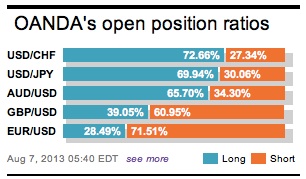It seems that we have officially entered our summer choppy mode with the lowest volume on Wall Street being recorded yesterday. Finding reasons or excuses for some of these market movements can be costly. So far, the Asian markets continue to give the rest of us a market lead. The region has again been spooked by fears that the US may withdraw its $85b monthly bond-buying program in a matter of weeks. These concerns have driven Tokyo equities down -4%, its biggest decline in over a month and been able to push the yen higher.

A lack of clarity over tapering is hurting the mighty dollar, particularly against the yen. A sharply higher yen is also fuelling the drop in Asian equities, as exporters are expected to suffer heavily. The Federal Reserve Bank of Chicago President Charles Evans said yesterday there had been “good improvement” in the labor market and indicated that a tapering of the central bank’s bond-buying program in September is possible. This comment coupled with a few others Fed members happened to spark the overnight Asian selloff. All along this market has been looking for any excuse to do something and demi-tapering is a perfect trigger for weakly participated market.
Prior to the overnight equity downfall and yen appreciation, the US stimulus measures have been responsible for heavy buying in Asia earlier this year, as global investors sought higher yielding assets – now its payback time, made more ripe by an illiquid market with premium pricing. Many had hoped that the Fed would entertain a $20b reduction in September on its bond-buying program if economic data were strong over the next six weeks. The market at the moment seems to be currently betting against this amount and is possibly settling for a $10-15b cut. The Fed so far has been somewhat surprised by the harsh market response in June to the tapering plans – so playing it safe is probably more prudent.

Former Canadian CBank Governor Mark Carney knows how to make a “big” impact with his new employer at the BoE. Lets try something different, become more transparent and provide the market some ‘forward guidance’ was his thinking. Cable certainly took it immediately on the chin as Governor Carney provided all the rhetoric information required to do exactly that this morning. Central Bankers of late have seemed to become more vocal in talking ‘down’ their currency – look at Governor Stevens at the RBA and Wheeler at RBNZ this week.
Cable temporarily threatened 1.5200 on his initial ‘dovish’ guidance comments. The BoE says it will not raise interest rates until unemployment falls to +7% (+7.8%). Currently they forecast UK jobless rate to stay above this threshold until at least Q3 2016. The Governor fully recognizes that no one indicator best describes the state of the economy. He acknowledges that the challenge for the MPC is to chart the best way to +2% inflation target – inflation, “not” employment is the MPC’s target. His biggest concern, the same fears when at the BoC, is the unwarranted change in rate expectations. Profit taking on short sterling positions heading into Carney’s speech has helped the currency to print an intraday high above 1.5350. Genuine offers again appear near last week’s outright high around 1.5414.

The market still has the BoJ to wait for tomorrow, and little is expected from them. As noted earlier, the market nerves come from profit taking in the Nikkei. This could also be linked to duration reductions globally which tends to create negative shocks in equities. By now it confirmed by policy makers that it’s certainly more difficult to guide the market when policy is loose in a slowdown than a recovery.

The 17-member single currency has thus far been reluctant to react after data surprise this morning – German industrial production rebounds to +2.4%, m/m from -0.8%. The currency’s initial reaction was a drift to 1.3293 then higher. The EUR has been slow to get going, but it is trying to suck in more of a bid now that German manufacturing looks to be gaining traction. Overall the market remains EUR bid at current levels, citing the fundamentally unchanged tone of the latest ECB decision, the rebound in Italian and Spanish PMIs above 50, and the dovish surprise from the FOMC all suggest the near-term risk for EUR outright is to the upside. Now, if only we could get more people to play!

Other Links:
Is The Fed’s Glass Half Full?
Dean Popplewell, Director of Currency Analysis and Research @ OANDA MarketPulseFX
This article is for general information purposes only. It is not investment advice or a solution to buy or sell securities. Opinions are the authors; not necessarily that of OANDA Corporation or any of its affiliates, subsidiaries, officers or directors. Leveraged trading is high risk and not suitable for all. You could lose all of your deposited funds.


